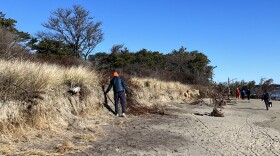When trying to find the best ash tree for basket weaving, scientist John Daigle said ash harvesters will closely examine a tree's bark, branches and the number of rings it has. Ash trees are an important part of the basket weaving tradition, which has long played a significant cultural, spiritual and practical role in the lives of tribal citizens across the country, including Daigle, who is a citizen member of the Penobscot Nation in Maine.
But the emergence of the emerald ash borer beetle, an invasive species that preys on ash trees, has posed challenges for Indigenous basket makers. A grant awarded to Daigle, a professor of forest recreation management at the University of Maine, could help as his research team aims to preserve and advance the craft.
It’s part of the Indigenous Forest Knowledge Fund, a program run by the Northeastern States Research Cooperative to support projects related to tribal homelands or ancestral territories of the Northern Forest region that includes Maine, New Hampshire, New York and Vermont.
Daigle’s project was one of three winners this year. His team will also look into developing technologies to support the processing and storage of ash splints before widespread ash mortality, which could help sustain basket-making supplies.
“Basket making has a really long history in New England, and for many of the tribes here in the Northeast, not just Wabanaki tribes here in Maine, but in New York and Canada.” Daigle said. “So it's a really important topic, especially in the face of the emerald ash borer that threatens our native ash trees in the Northeast.”
The Indigenous Forest Knowledge Fund has been able to fund 11 projects since its relaunch in 2021. The goal is to advance tribal forest research and traditional ecological knowledge.
A committee of tribal leaders and scholars select grant recipients that reflect the emerging research needs and priorities of Indigenous communities, said Casey Thornburgh, a citizen of the Mashpee Wampanoag tribe in Massachusetts who works as an advisor for the NSRC.
“When it's tribal or Indigenous-led, it's going to really focus on accomplishing a program or project that's going to be of immediate benefit to a tribal nation and community,” he said.
About $1.2 million was awarded in total for 2025.
A New York-based project was also selected this year that aims to restore understory plants of ecological importance and cultural significance to Indigenous nations. Another Maine-based project focused on strengthening tribal forestry and the fire management workforce by providing training, education and employment opportunities also received funding.
Requests for proposals for the next year’s grant money typically come out in the spring.







